Competitive Nature Ensures Popularity of Improvisational Theatre in the Netherlands and Belgium
Since the end of the 1980s, improvisational theatre, or improv, has seen an impressive uptake, in the Netherlands, but even more so in Belgium, and then especially in Wallonia. Its competitive, gaming element is remarkable. The form ‘theatresports’, imported from England, is popular in the Netherlands; in Belgium, there is the ‘impro match’, so called after the ice hockey matches in French-speaking Canada. It is precisely this competitive nature that ensures improv’s lasting popularity, especially among amateur players in the Netherlands and Flanders.
In his still very relevant study The Seven Ages of the Theatre (1962), the English scenographer and theatre historian Richard Southern explores the essence of drama. Among other things, he discusses a primitive ritual from Bavaria that takes place on the night of December 6th, where men, in costume and masks, emerge from the woods on skis to chase young girls in the hope of a kiss.
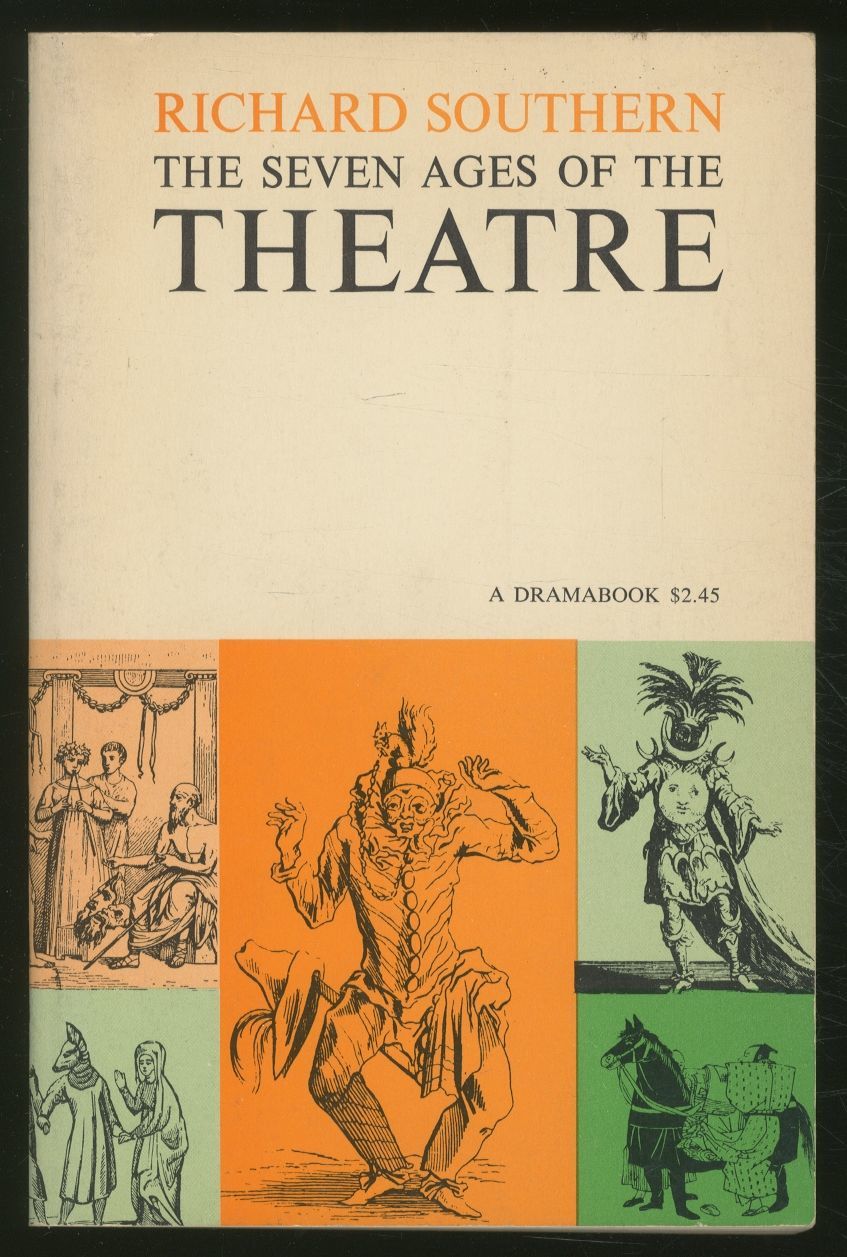
Is that theatre, he wonders. The answer is both yes and no. No, because there is no speech, no acting, no specified location for the performance, no stage, no set, no prior rehearsals. But also yes, because there are costumes and masks, but above all, there is improvisation: “not one of these ‘performers’ can know just what will happen or how the night will go”. And, says Southern, for an actor such improvisation is inescapable, even today: “that particular quality of the unpredictable, and its accompanying demand for a quick ability to improvise, is a quality of all theatre.”
You don’t have to have performed on stage to know this. By definition, theatre is unpredictable, no two performances can be exactly alike. Actors must constantly be alert to slips of the tongue, forgotten lines, the delivery of their fellow players, an unforeseen audience reaction.
Making such a requisite a challenge, purposely seeking out the risks involved, keeping a performance “fresh” by means of creative moments chosen ad libitum: skilled actors in particular take pleasure in this and it is precisely that thrill of improvisation which sets it apart as an independent genre, a discipline that has enjoyed enormous popularity in the Netherlands and Belgium over the past three decades.
Theatresports in the Netherlands
Improvisation here does not refer to a method of training in rehearsals or about performances that result from an improvisational process. In the professional circuit, such productions are increasingly common: where the traditional concept of performances based on a fixed (theatre) text is abandoned, improvisation may become a catalyst for naming, analysing, and shaping topics of current interest.
As a genre of its own, improvisational theatre is not new. In the Late Middle Ages the commedia dell’arte in Italy, for example, had no fixed rules or written lines. A performance developed around certain character types, such as the doctor, the chambermaid and the servant, and followed a pattern that could be varied at will.
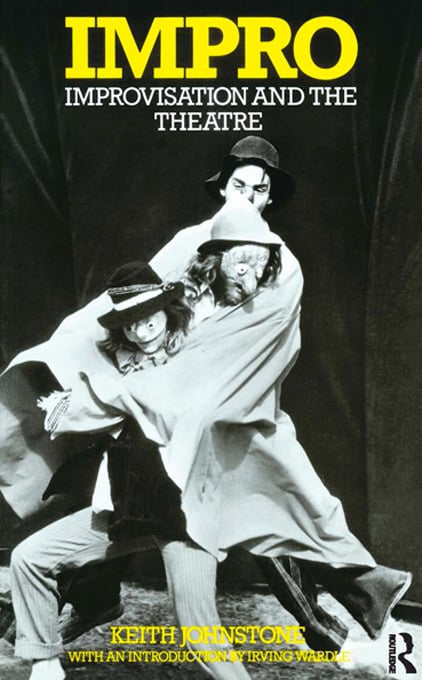
Creating a performance from fixed character types, along casually plotted storylines: somewhere in the 1960s in England this stoked the imagination of “improvisation guru” Keith Johnstone. His name features in practically all discussions relating to improvisational theatre as it is now practised in many countries.
The theatresports genre in particular, inspired by a wrestling match Johnstone attended, gained a foothold worldwide and at the end of the 1980s was also rapturously received in the Netherlands. The form was particularly popular with students, and societies sprung up one after the other in university cities. As a result, theatresports gradually became a serious competitor to the conventional student theatre.
The competitive games element, which makes winners and losers, is undoubtedly a large factor in its success. Usually it goes like this: two teams of four players challenge each other to spontaneously create, for example, the most comic or the most tragic scene, a scene set in a historical era or in the future.
The games master invites the audience to suggest the ingredients of an improvisation
The games master, at the centre of events, invites the audience to suggest the location, historical period, relationship between the actors, to make up the title of a fictitious film. And so on. Those ingredients may throw up an aunt and her two cousins on a sandy Portuguese beach in the nineteenth century in a chilling scene from the as-yet-unreleased film Forbidden Fruits. Of course, daredevils would even act the scene in made-up Portuguese. To give a few examples.
A successful match is determined not only by players’ individual qualities and their ability to play well together, but also by the performance of the games master, the jury members, and any musician present. Their task is to “interpret” the course of the contest, to enable the players to act their best and to ensure the audience is thoroughly amused. Often there are three judges, deliberately strict. They are an essential part of the entertainment, and intentionally provoke disapproval or approval from the teams of supporters among the public.
However, the awarding of points is not up for debate: the entertainment value comes first, but the assessment – on elements such as originality and technique – is taken seriously.
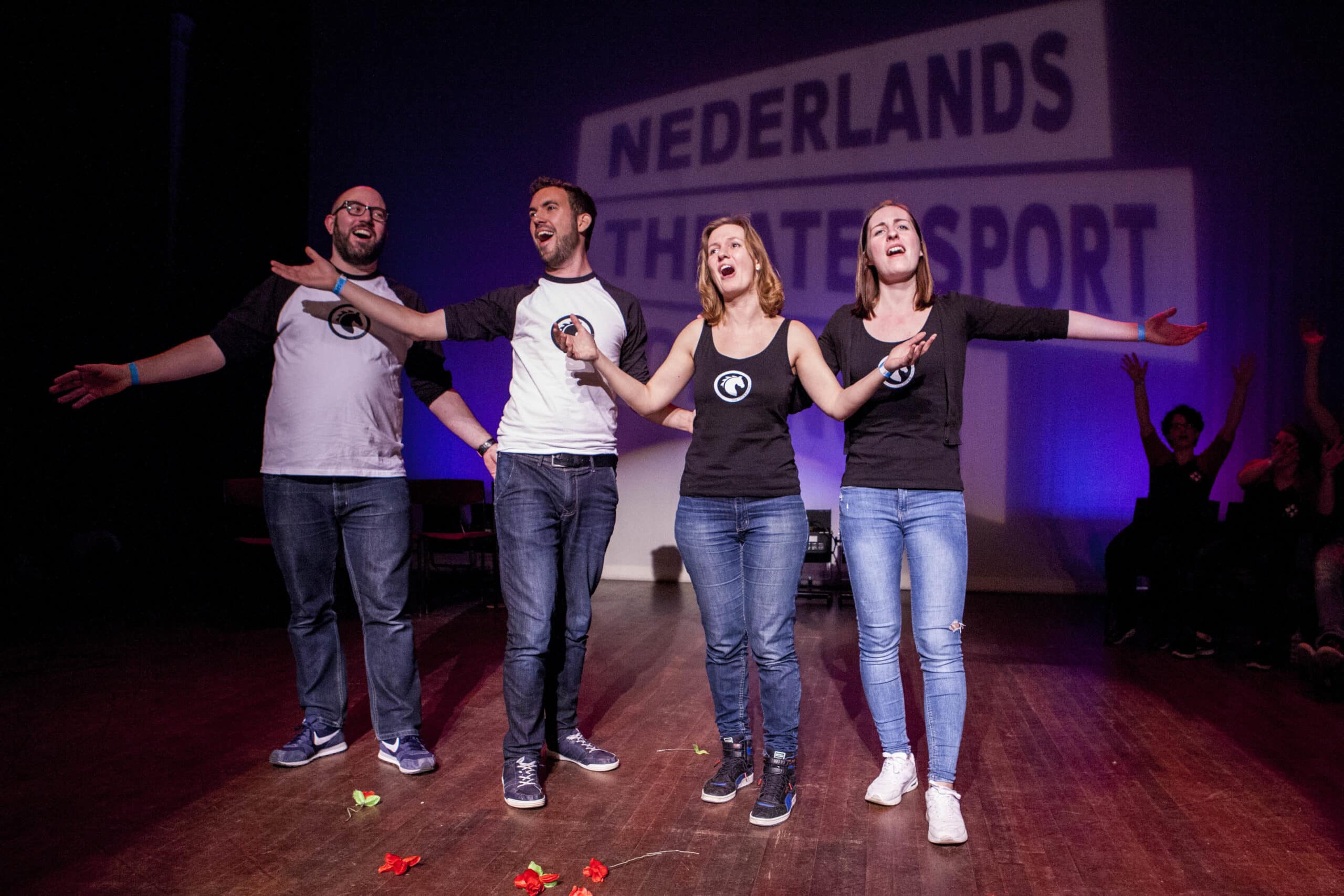 Dutch Theatresports in Utrecht
Dutch Theatresports in UtrechtⒸ Eefke Burg
Naturally, the competitive element leads to many lively exchanges between (student) associations. For the Dutch Theatre Sports Tournament in Utrecht, established in 2011, nearly fifty teams now come to that city every year.
Improv groups want to get better at what they do, and like training for competitive sports, theatresports associations strive to refine improvisation techniques through courses and workshops. For example, TVA IMPRO, which started out as a theatresports association in 1989 in Amsterdam, has since grown into a full training course in improvisational theatre. The international festival IMPRO Amsterdam, originally organised by this theatre company, had more luck in terms of timing than the Utrecht tournament: its twenty-fifth edition took place just before the pandemic broke out in the Netherlands.
The impro match in Belgium
Johnstone’s ‘theatresports’ proved less successful in Belgium than in the Netherlands, but even in Flanders, Wallonia and Brussels, it is the competitive element of improvisational theatre that has contributed to its increasing popularity. Since 1989, the Belgian Improvisation League (BIL) has almost exclusively performed the ‘impro match’ variety from Canada.
For the emergence of this form, we have to go back to 1977. That year in Quebec, actor and director Robert Gravel set up an improvisation league together with actor Yvon Leduc to rid theatre of its elitist image and bring it closer to the public. Elements from the world of ice hockey were – and still are – translated into theatre, mainly by professional comedians.
The stage is set amongst the audience, in the shape of a small ice hockey ring. Both teams, consisting of seven players, wear coloured and numbered shirts; the referee and two aides wear black and white striped tops. A games master and a musician complete the scene.
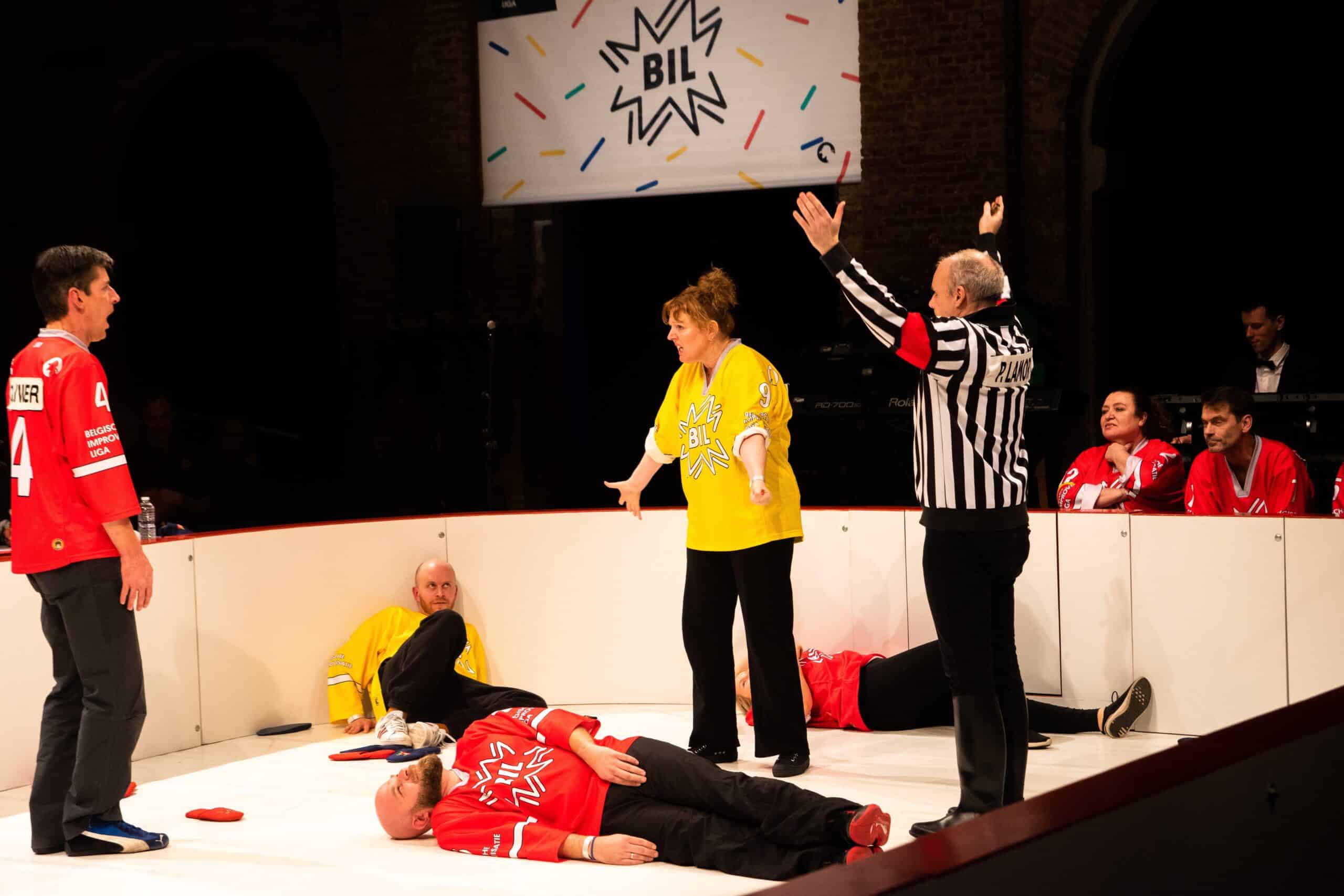 The Belgian Imorovisation League performs an "impro match"
The Belgian Imorovisation League performs an "impro match"Ⓒ Dirk Den Aantrekker
The rules of play are determined by chance and, if so desired, adjusted by the head referee, whether or not on the advice of the other staff members. In this way a title can be chosen, a theme, a genre, the length of play, and so on. During the match, the audience participates by, for example, throwing slippers in disapproval or by showering the referee with scorn, and at the end of a scene the winning team is chosen.
Of course, the impro match is also about entertainment, although the referee plays a much more clearly defined role than the judge’s guild in theatresports. With a fixed code of hand gestures, he or she indicates which rule of improvisation is being flouted: the agreed-upon genre might be disregarded, a performance might slow down the action or an inspiration from a fellow player might be ignored. The number of “violations” is counted in the result.
After impro match became a fixture at the prestigious Avignon theatre festival in 1982, the genre began to catch on in Europe. In Antwerp, the BIL grew from a modest group of amateur players to an organisation with almost a hundred members. The improvisation competitions are the main attraction, but the company now also offers workshops and adapted programmes for schools and businesses.
After impro match became a fixture at the prestigious Avignon theatre festival in 1982, the genre began to catch on in Europe
A hilarious format called Bingo, borrowed from the French-language company Tadam from Brussels, is a sure hit. The rules of bingo determine which roles the actors get assigned in a scene and which direction the performance should take.
The Ligue d’Improvisation Belge Professionnelle (LIB), the older, French-speaking counterpart of the Belgian Improvisation League, and the Ligue d’Improvisation Professionnelle Wallonie–Bruxelles (LIP) operate from Brussels. In addition to the impro match as a so-called shortform, which can also include theatresports, advanced players in both leagues practise longform variants: improvisation techniques with which even full-length shows are created, with continuous storylines, tension building and elaborate plots.
Finally, some thirty amateur companies are members of the very active Fédération Belge d’Improvisation Amateur (FBIA), an umbrella organisation with more than 400 members in French-speaking Belgium. Traditionally, this organisation has approached theatrical improvisation not only as an artistic discipline, but also as a tool for emancipation. The latter aspect is reflected, among other things, in the special attention to working with young people: there are educational programmes for schools and youth centres, summer camps and inter-university tournaments.
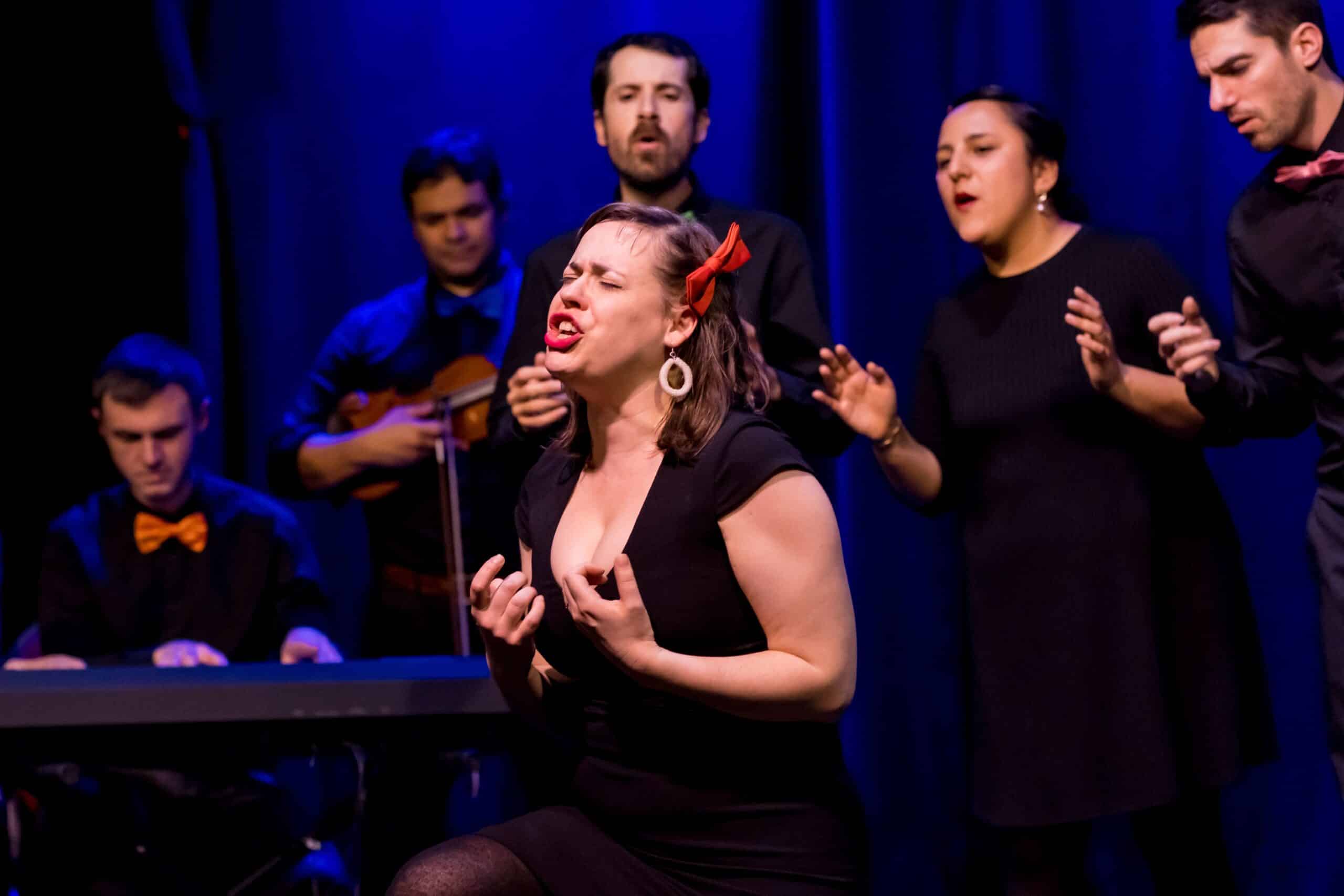 L'Improviste, Brussels.
L'Improviste, Brussels.Ⓒ Sébastien Devienne
Every four years, the FBIA organises the World Improv Tournament, together with regular partners from the countries where impro match is most popular: Canada (Quebec), France, Switzerland, and Italy. Needless to say, in 2020 virtually all events were cancelled owing to the pandemic – thus sympathetically judged to have ended “in a draw”.
Media influence
Clearly, Belgium, and in particular the French-speaking part, is the undisputed champion when it comes to improvisational theatre that is practised not only at amateur but also (semi) professional level. Professional improvisers, albeit part-time, are also found in the Netherlands, but only – if we disregard the English-language comedy shows of the improvisation collective Boom Chicago from Amsterdam – in a handful of television programmes, of which the two best-known are De Lama’s (Llamas) and De vloer op (Get on the stage).
Between 2004 and 2008, De Lama’s appeared as a television series with mainly young stand-up comedians. Game rules, taken partly from theatresports, were used to create short, flashy scenes, often hilarious, sometimes downright bland. The programme had several sequels and spin-offs and also ran in theatres for a number of seasons.
From 2000 onwards, Dutch viewers became acquainted with the ‘longform’ type thanks to the De vloer op show, in which creator and presenter Peter de Baan presented professional, well-known actors with situations on the basis of which they had to create a micro-performance of about fifteen minutes. The live improvised scenes were sometimes hilarious, but just as often heart-warming and moving. As a bonus, the programme brought the craft of professional actors into view and provided insight into what goes on behind the scenes. From 2012, De vloer op developed a junior series, in which core actors worked together with talented young people on assignments that spoke to their experiences. In the 2018-2019 season, a De vloer op tour of Dutch theatres followed, after which the programme ended definitively in 2020.
In Flanders, improv became more widely known through the television programme Onvoorziene omstandigheden
(Unforeseen circumstances; 1994-1995), with members from the BIL whose fame increased thanks to this television debut. The format was very similar to that of De Lama’s (Llamas): both programmes were inspired by the popular UK and (later US) comedy show Whose Line Is It Anyway? And here, too, the reach extended beyond the studio: the actors toured various stages with the performance “Gorilla Theatre”, a name that refers to another form of improvisation developed by Keith Johnstone.
Other successful television programmes based on the format of improvisation included De rederijkers (The rhetoricians; 2001-2003), GodzijDank (Thank God; 2007) and Spelen met uw leven (Playing with your life; 2013), with guest appearances by Flemish television personalities, and presented, like Onvoorziene omstandigheden (Unforeseen circumstances), by Mark Uytterhoeven.
The fact that improvisational theatre has made it into living rooms thanks to these and other, similar programmes has obviously contributed to the popularity of the genre. This is perhaps less apparent from its professional practice than from the many amateur societies that have been set up. And in addition: the competitive form in particular is ideal for family gatherings and friends’ parties, and is an accessible stepping-stone for team building during company outings.
Inner resources
Anyone in the Netherlands who wants to enjoy an evening of improvisational theatre can, of course, subject to the covid measures of the day, attend one of the amateur level theatresports competitions. In Flanders, attending an impro match is the obvious choice, but there too the genre is hardly practised by professional actors.
The situation is different in Brussels, where, for example, the theatre L’Improviste is entirely devoted to improvisation, in times of covid-19 even via live stream. And, for example in Charleroi, where the Improcarolo comedians improvise at a professional level, and in Mons, where the so-called Caméleons perform on stage every month. Almost always, such ensembles also offer training and further development opportunities, for both beginners and advanced students.
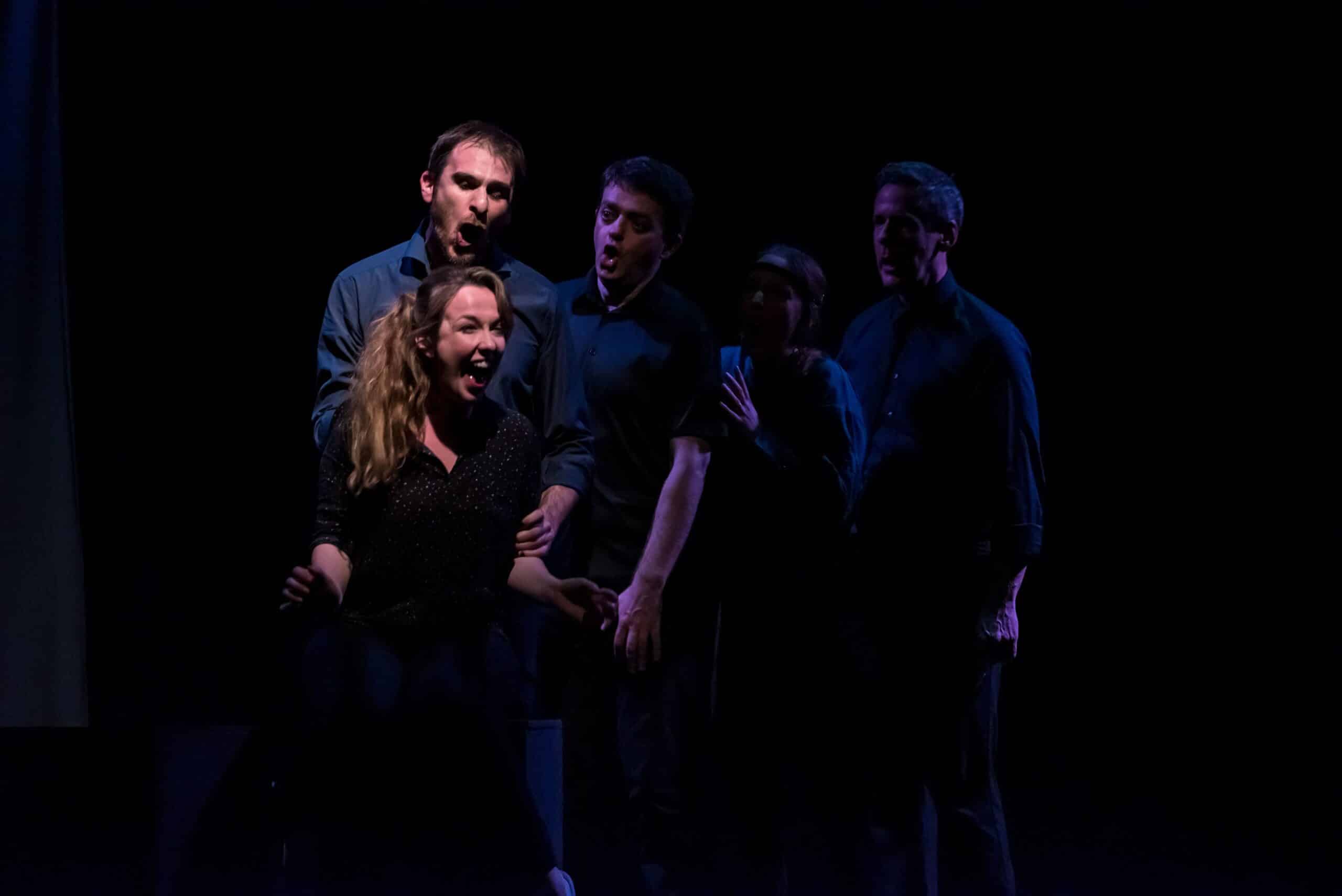 L'Improviste, Brussels
L'Improviste, BrusselsⒸ Sébastien Devienne
We go back to the beginning: the essence of theatre that Southern was looking for. What is the minimum required to call something theatre? His compatriot, the theatre legend Peter Brook, kept it simple in his now standard work The Empty Space (1968): for theatre to exist, he thought, no more is needed than an actor and a floor. This simplicity seems eminently applicable to improvisational theatre, where there is no need for set pieces, props, make-up, costumes, light, or sound technology. Without that baggage and – what’s more – even without pre-rehearsed lines, actors are completely thrown back on their inner resources, physical abilities, voice, craftsmanship.
During the theatresports workshops and presentations in which I participated in Leiden in the early 1990s, I learned a great deal about how beautiful micro performances can be created from scratch. Every course instructor and every handbook on improvisational theatre will tell you that to do this actors must: pay attention, focus, move with the flow, stay in the present, not ignore others, not look for ways out, forget about originality, trust their fellow players, react spontaneously.
What I find so beautiful and so special about this is these are not only essential tools to be able to fully participate in the performance as a player, but also skills that you can put to good use in your personal life.
Ultimately, improvisational theatre, for both player and spectator, is a sometimes unsuccessful, sometimes successful, but always fascinating play with the unpredictable. The viewer can allow himself to be transported to a fantasy universe along still untrodden paths, purely relying on his own imagination and by opening himself up to a story told well. The actor, together with his fellow actors, can find ultimate satisfaction in the ability to bring about that miracle.












